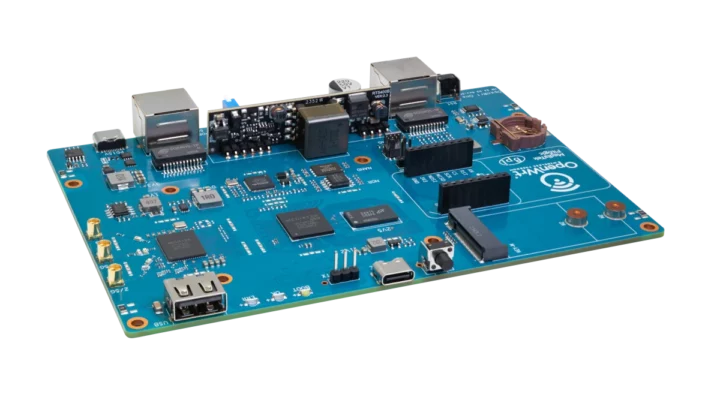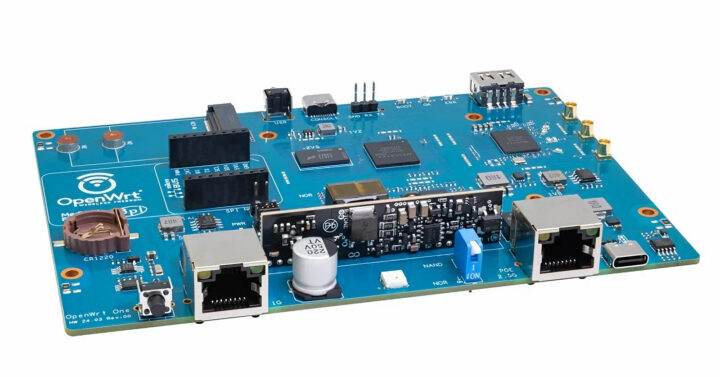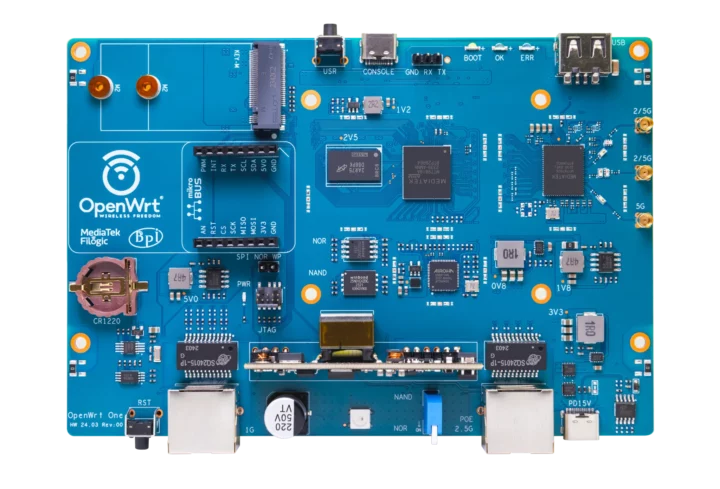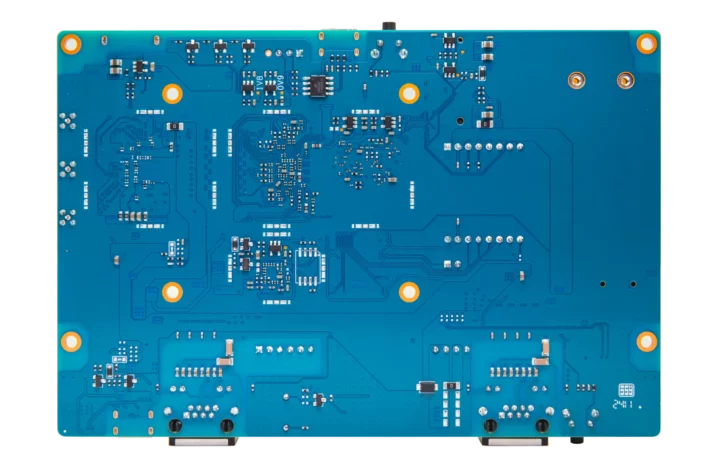John Crispin has recently received the first samples of the “OpenWrt One/AP-24.XY” Filogic 820-based WiFi 6 router board, manufactured by Banana Pi. Those will be officially supported by OpenWrt developers with assistance from MediaTek.
Announced in January 2024, we only had the specifications of the OpenWrt One router so far, but since the first samples are now available we have more details including several photos of the board, and some units will be auctioned away at the OpenWrt Summit taken place in Cyprus on May 18-19.
John explains fifteen prototypes will be manufactured, a website will be set up (maybe openwrt dot one), and that MediaTek helped with documentation:
Just dropping a quick update on the OpenWrt One project. I’ve received the first batch of three PCBs for testing today. I am in the process of testing the hardware to make sure everything works as intended. There are twelve further early prototype boards on standby in case we need to tweak anything hardware-wise…
Work is underway to establish a website where all legal information and links to our sources will be provided. Keeping everything transparent and accessible is crucial for us. MediaTek also generously released a substantial amount of programming manuals for the SoC used by the OpenWrt One which will be made available shortly.
Here’s a reminder of the OpenWrt One router specifications:
- SoC – MediaTek MT7981B (Filogic 820) dual-core Cortex-A53 processor @ 1.3 GHz
- System Memory – 1GB DDR4
- Storage
- 128 MB SPI NAND flash for U-boot and Linux
- 4 MB SPI NOR flash for write-protected (by default) recovery bootloader (reflashing can be enabled with a jumper)
- Two types of flash devices are used to make the board almost unbrickable
- M.2 2242/2230 socket for NVMe SSD (PCIe gen 2 x1)
- Networking
- 2.5GbE RJ45 port
- Gigabit Ethernet RJ45 port
- Dual-band WiFI 6 via MediaTek MT7976C (2×2 2.4 GHz + 3×3/2×2 + zero-wait DFS 5Ghz)
- 3x MMCX antenna connectors
- USB
- 1x USB 2.0 Type-A host port
- USB Type-C (device, console) port using Holtek HT42B534-2 UART to USB chip
- Expansion – MikroBUS socket for expansion modules
- Debugging – Console via USB-C port or 3-pin header, 10-pin JTAG/SWD header for main SoC
- Misc
- Reset and User buttons
- Boot select switch: NAND (regular) or NOR (recovery)
- 2x PWM LEDs, 2x Ethernet LED (GPIO driven)
- EM6324 External hardware watchdog
- NXP PCF8563TS (I2C) RTC with battery backup holder for CR1220 coin-cell
- Power Supply
- 12V USB-PD on USB-C port (might have changed to up to 15V)
- Optional 802.3at/af PoE via RT5040 module
- Dimensions – 148 x 100.5 mm compatible with Banana Pi BPI-R4 case design
- Certifications – FCC/EC/RoHS compliance
 There’s still no information about mass production and general availability, but at least one or two samples will be given away during the OpenWrt Summit according to a discussion thread started by Arnç ÜNAL on April 10. John further added that the 15 EVT samples mentioned have already been tested, and a new production run of 100 DVT samples would start shortly. These 100 samples will have OpenWrt OUI macs and calibration data, and the winners of the auction will receive samples via express courier (as opposed to being given at the OpenWrt Summit).
There’s still no information about mass production and general availability, but at least one or two samples will be given away during the OpenWrt Summit according to a discussion thread started by Arnç ÜNAL on April 10. John further added that the 15 EVT samples mentioned have already been tested, and a new production run of 100 DVT samples would start shortly. These 100 samples will have OpenWrt OUI macs and calibration data, and the winners of the auction will receive samples via express courier (as opposed to being given at the OpenWrt Summit).

Jean-Luc started CNX Software in 2010 as a part-time endeavor, before quitting his job as a software engineering manager, and starting to write daily news, and reviews full time later in 2011.
Support CNX Software! Donate via cryptocurrencies, become a Patron on Patreon, or purchase goods on Amazon or Aliexpress








So close, yet so far. Better luck next time.
I’d love a firmly supported openwrt router but with my ISP moving beyond gigabit I need at least 2x 2.5gbe ports. It’ll have to be the bpi-r3 or r4 even if they risk being janky.
Why do they even bother with the 2.5gbe, i don’t see the point if there is only one.
2.5x more bandwidth, obviously. Number of ports doesn’t matter if you plug the board into managed switch and use vlans.
I don’t think that companies who have 2.5+gbe managed switches are gonna want to use openwrt on a Chinese board.
What is a ‘Chinese board’ and why would one fear something like that?
Yeah, that’s their problem. Other people have 2.5x more bandwidth. 😀
with 2.5Gbit uplink you have bandwidth for both wifi and 1GBit ethernet. And lot of people actually use wifi only for internet access so one 1GBit LAN port is more than enough for some. And did you notice you can nowadays have speeds over 1GBit just via ax wifi?
What is the interrest of this board ? Sorry but it’seems obsolète already ? No ?
Well, it has the tech specs of the EspressoBin released 7 years ago, but in a larger form factor. I think it’s safe to assume that 7 years starts to count as obsolete in the network domain 🙂
This has quite modern AX wifi 6 dual band chip, it is quite unlikely EspressoBin had this 7 years ago.
It had a mini-pcie slot so this is even better, you can plug what you want and even update it to stay at top speed as new standards emerge. An AX210 WiFi 6E card advertising up to 2.4 Gbps costs only $20. That’s not worth the hassle of buying a complete new system, reinstall and reconfigure everything.
Yes, this can be true when the system is more expensive. In my case I was thinking about upgrading old router and new concurrent dual band ax card was in $50-$60 range (and two separate cards for 5 and 2.4 were even more expensive in total). New router was $34 and draws 1/3 of the power of old system (~5 vs ~15Watts) and has faster CPU.
it was never meant to be a top tier router but a reference board for openwrt hobbyists like me 🙂
Do the mediatek chip have any advantage for routing over a cheaper x86 chip? Considering that you have to buy a power supply, SSD and etc.
I believe that for most consumers, it doesn’t really matter as consumer routers would just go to the ISP router which will do the actual intra and inter routing.
What people would really want is firewall usage and other such applications which then this is probably underspecced for.
most consumers don’t really know what a firewall is so …
Wow, im underwhelmed.
A board that fits the needs of a handful of tinkerers and nobody else’s.
The USB serial console is mostly unnecessary, as they have serial headers, and every $1 USB to serial board will do.
The POE module, that most users won’t need, drives the cost up. Why not simply use a socket instead?
No switch, no SFP. USB2 host? GTFO.
And why MMCX antenna connectors? On a board that big, they could’ve used angled SMA to directly connect antennas.
Seriously, what use case does this thing even fit?
POE is optional, the rest is driven by cost, it has only what Filogic 820 gives you ‘for free’, switch is another chip. angled SMA means they would decide antenna locations for you. Personally I like it if the cost will be reasonable for what it is. I currently have Xiaomi AX3000T which is same platform but I’d like more expandablity this thing has (USB, PCI-E, SPI). I have no use for builtin switch, one WAN and one LAN port is enough.
WRT54G had a switch at least!
Share details on how to contribute for this OpenWRT One community? Also where this reference board can be ordered?